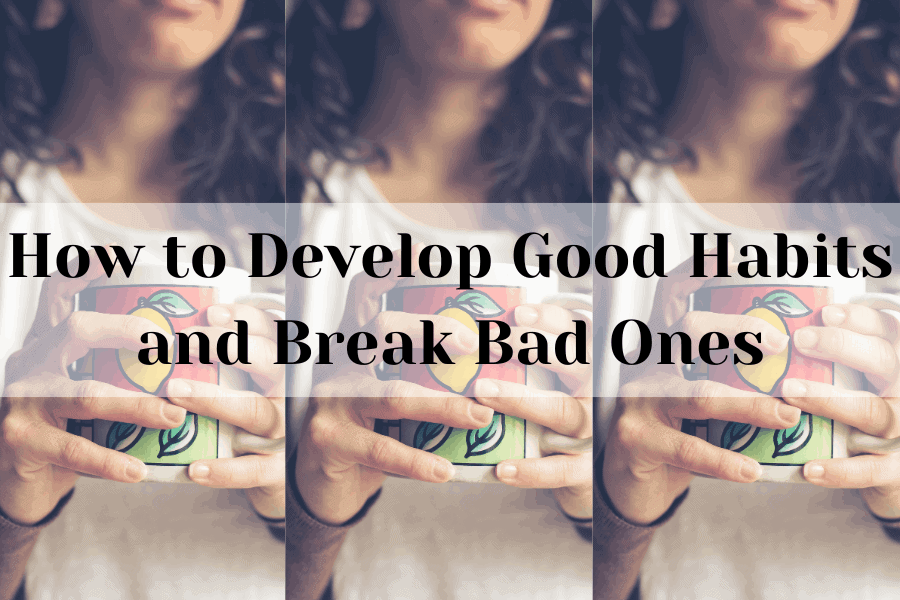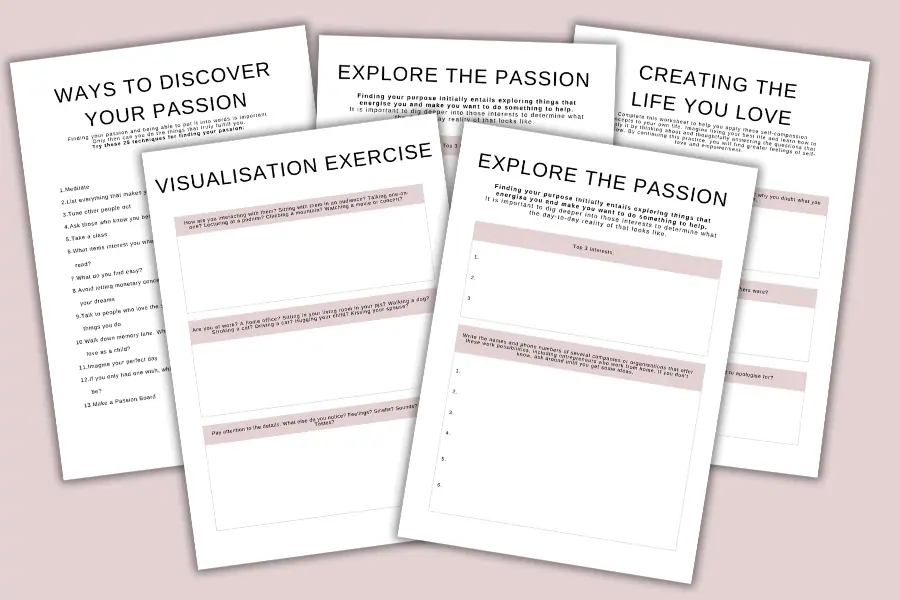How to Develop Good Habits and Break Bad Ones

Learning how to develop good habits and sticking to them can be one of the most challenging things in life! We all know having a good morning routine, eating healthy foods and reading more are all good habits, but creating daily habits to achieve these can be difficult.
Don’t fear, I’m here to help! In this blog post, we will discover how to develop good habits and what impact they can have on our lives.
This blog post is about how to develop good habits

What are Habits?
Habits are like the gears that keep the engine of our lives running smoothly. They can be as simple as brushing your teeth before bed or as complex as a daily exercise routine. Habits are formed through a three-step process called the “habit loop”: cue, routine, and reward. The cue triggers our brain to initiate the routine, leading to a specific reward. Over time, this loop reinforces the habit, making it more automatic.
Learning to develop good habits is crucial for personal development because they directly impact our daily actions and decisions. Positive habits empower us to make consistent progress toward our goals, whether it’s improving our health, advancing in our careers, or enhancing our relationships. On the other hand, bad habits can hinder our growth, trapping us in counterproductive patterns.
Benefits of Developing Habits
Habits influence nearly every aspect of our lives, from our morning routines to how we unwind at night. They shape our productivity, time management, and overall efficiency in achieving our goals. Imagine the cumulative effect of making small positive changes in your daily habits, leading to significant long-term outcomes.
For instance, consistently waking up early and starting your day with a healthy breakfast can boost your energy levels, productivity, and mood throughout the day. Similarly, cultivating the habit of reading for personal growth can expand your knowledge and perspective over time. On the other hand, negative habits like excessive social media use can eat up precious time and lead to decreased focus and well-being.
Understanding the impact of habits on our lives empowers us to take control of our behaviours and make intentional choices that align with our aspirations. By developing good habits and replacing bad ones, we pave the way for a more fulfilling and successful life journey. So, let’s dive into the practical steps of how to develop good habits and make positive changes that stick.
The Habit Loop
Imagine habits as a loop that starts with a cue, goes through a routine, and ends with a reward. This is known as the habit loop, a fundamental principle in understanding how habits are formed and maintained. The cue is the trigger that initiates the habit, the routine is the action or behaviour itself, and the reward is the positive reinforcement that follows.
For instance, let’s consider the habit of going for a morning run. The sound of your alarm (cue) signals the start of your run, you go out and jog for 30 minutes (routine), and afterwards, you feel refreshed and energised (reward). The reward reinforces the habit, making it more likely that you’ll repeat the behaviour the next time you hear the alarm.
How habits are formed
Habits are formed through a process known as “chunking,” where our brain groups a sequence of actions into a single automatic routine. When we repeat a behaviour consistently in response to the same cue, the brain streamlines the process to be more efficient. With enough repetition, the behaviour becomes second nature, making it easier and more automatic to perform.
In the beginning, developing a new habit might require conscious effort and willpower, but as you repeat the routine and experience the rewards, it becomes ingrained. This is why consistent practice is crucial when trying to develop good habits. The more you reinforce the habit loop, the more automatic and natural the behaviour becomes in your daily life.
The role of the brain
The brain plays a central role in habit formation. When a cue triggers a habit, the brain’s response is automatic, freeing up other parts of the brain to focus on other tasks.
Additionally, the brain’s reward system plays a vital role in reinforcing habits. When we receive a reward after completing a routine, the brain releases dopamine. This surge of dopamine creates a positive feeling, linking the behaviour to the reward and strengthening the habit loop.
This aspect of habit-forming can be a bit heavy, but understanding the brain’s role in habit formation helps us see why habits can be both powerful and challenging to change. It also highlights the importance of choosing rewarding and positive behaviours to cultivate healthy habits.
By being aware of the habit loop and how habits become automatic, we can be more intentional in our habit development process. To build good habits, identify clear cues, design routines that align with your goals, and ensure the rewards are genuinely satisfying. This way, you can leverage the power of the habit loop to create lasting positive changes in your life.
Identifying Current Habits
Take a moment to reflect on your daily routines. Notice the actions that have become automatic – the good and not-so-good ones. Be honest with yourself about what habits shape your life.
Recognising your habits
Awareness is key. Sometimes, habits control us without us even realising it. By being mindful of our behaviours, we can spot habits that might be holding us back or causing harm.
Recognising our current habits is like shining a light on the path to positive change. Now, let’s see how tracking habits and adopting a growth mindset can amplify this journey of self-improvement.
Setting Goals
Before diving into habit development, it’s crucial to know where you want to go. Setting clear goals and priorities gives your habits direction and purpose. Without a destination in mind, habits might lack focus and effectiveness.
SMART goal setting
The SMART goal-setting framework is a powerful tool for crafting meaningful objectives:
Specific: Define your goal with precision. Be clear about what you want to achieve, avoiding vague or broad statements.
Measurable: Make your goal quantifiable. Include specific metrics to track progress and know when you’ve achieved it.
Achievable: Set realistic goals that you believe you can reach with effort. Aim high but within the realm of possibility.
Relevant: Align your goal with your values and long-term aspirations. Ensure it connects to your overall vision for personal growth.
Time-bound: Set a deadline for achieving your goal. A time frame creates a sense of urgency and helps you stay on track.
By applying the SMART framework, you convert dreams into actionable targets. For example, transforming “I want to exercise more” into “I will jog for 30 minutes every morning for the next three months” makes it specific, measurable, achievable, relevant, and time-bound.
When your habits are tethered to well-defined goals, they become powerful tools for personal transformation. Now, let’s explore how to choose the right habits to develop, starting with small, manageable changes.
Choosing the Right Habits to Develop
To develop effective habits, it’s essential to align them with your long-term goals and personal values. Reflect on what truly matters to you and what you want to achieve in life. Choose habits that support these aspirations and contribute positively to your well-being and growth.
For instance, if your goal is to lead a healthier lifestyle, habits like regular exercise, balanced nutrition, and mindfulness practices would be in sync with your values of well-being and self-care.
Start small
Starting small is the secret to habit success. Focus on manageable habits that you can easily incorporate into your daily routine. It might be tempting to take on too much at once, but that often leads to burnout and discouragement.
Instead, begin with tiny changes that are easy to sustain. For example, if your goal is to read more books, start by committing to reading ten pages a day. As you develop consistency, you can gradually increase the challenge.
Small wins create momentum and confidence, propelling you to take on more significant habits over time. As the saying goes, “Small hinges swing big doors.”
By choosing habits that resonate with your purpose and starting small, you set yourself up for success on your habit development journey. Now, let’s explore the common challenges that might arise and how to overcome them on your path to building good habits.
Overcoming Challenges
Embarking on a habit development journey is exciting, but it’s not without its challenges. Two common obstacles that can impede progress are procrastination and lack of motivation.
Procrastination: Procrastination is the art of delaying tasks, often opting for short-term pleasures over long-term benefits. It can keep you from starting or sticking to new habits, making it difficult to achieve your goals.
Lack of motivation: Motivation can fluctuate, and there will be days when you feel less inspired to follow through with your habits. During such times, it’s easy to fall back into old routines or give up on forming new ones.
Strategies for overcoming challenges
Accountability partners
Find a friend, family member, or colleague who shares similar goals and values. Having an accountability partner can provide the support and encouragement you need to stay on track. You can check in with each other regularly, share progress, and offer motivation during tough times.
Habit tracking
Use habit-tracking tools, like apps or habit journals, to monitor your progress. Seeing your daily successes builds a sense of accomplishment and keeps you motivated. If you notice a dip in consistency, the tracking process allows you to reevaluate and adjust your approach.
Break habits into smaller steps
If a habit seems overwhelming, break it down into smaller, more manageable steps. Instead of trying to master a complex habit all at once, focus on one element at a time. For example, if your goal is to eat healthier, start by incorporating more vegetables into your meals before making other changes.
Celebrate milestones
Acknowledge and celebrate your achievements along the way. Celebrating milestones, no matter how small, reinforces positive behaviour and encourages you to keep going.
Cultivate a positive environment
Surround yourself with a supportive environment that nurtures your habits. Remove temptations that may derail your progress and instead create a space that fosters motivation and focus.
Practice self-compassion
Habits take time to solidify, and setbacks are a natural part of the process. Instead of beating yourself up for occasional slip-ups, practice self-compassion. Be kind to yourself and treat setbacks as opportunities for growth and learning.
By addressing obstacles and implementing these strategies, you can overcome challenges that may arise while developing good habits. Remember that persistence and consistency are key to building lasting positive changes in your life.
Creating a Habit Action Plan
Make it personal
Identify your target habit
Choose one specific habit you want to develop. It could be related to your goals, values, or areas you want to improve.
Set clear goals
Apply the SMART framework to define clear and achievable goals for your target habit. Make it specific, measurable, achievable, relevant, and time-bound.
Break it down
Divide the habit into smaller, manageable steps. Breaking it down makes the process less daunting and builds a sense of progress.
Define your cues
Determine the triggers or cues that will prompt you to perform the habit. These cues should be easily recognisable and integrated into your daily routine.
Create a routine
Design a step-by-step routine for your habit. Keep it simple and realistic to increase the likelihood of success.
Set up rewards
Establish rewards for each successful completion of the habit. Positive reinforcement encourages repetition and helps solidify the habit loop.
Prepare for challenges
Anticipate potential obstacles and develop strategies to overcome them. Having a plan in place will help you stay on track when faced with difficulties.
Track your progress
Use habit trackers or journals to monitor your daily efforts. Tracking your progress helps you stay accountable and motivated.
Adjust and adapt
Be open to refining your action plan as you go along. Flexibility allows you to tailor the plan to your changing needs and circumstances.
Staying consistent
Set reminders
Use phone alarms, sticky notes, or digital reminders to prompt you when it’s time to practice your habit.
Build habits into routines
Incorporate your new habit into existing daily routines. Pair it with activities you already do consistently.
Use habit stacking
Attach the new habit to an existing one. This association makes it easier to remember and increases the likelihood of consistency.
Practice gratitude
Cultivate gratitude for the opportunity to develop new habits. Embrace the journey and embrace the positive changes it brings.
Visualise success
Imagine yourself successfully executing your habit and reaping the rewards. Visualisation strengthens your commitment and mental readiness.
Be patient and persistent
Habits take time to form. Be patient with yourself and continue practising, even on days when motivation is low.
By creating a habit action plan and incorporating these strategies, you pave the way for successful habit development. Remember that building good habits is an ongoing process, and every step you take brings you closer to a more fulfilling and productive life. Let’s now explore how adopting a positive mindset can reinforce your journey to better habits.
Developing a Positive Mindset
How a positive mindset supports good habits
A positive mindset serves as a powerful catalyst for habit formation. When you approach habit development with optimism and a can-do attitude, you create a fertile ground for success. Here’s how cultivating a positive mindset can benefit the formation of good habits:
Increased resilience
A positive mindset helps you bounce back from setbacks and stay motivated during challenging times. Instead of being discouraged by occasional slip-ups, you view them as opportunities for learning and growth.
Enhanced self-efficacy
Believing in your ability to change and develop new habits boosts your self-efficacy. With a positive outlook, you’re more likely to embrace challenges and persevere until you achieve your goals.
Greater focus on solutions
Positivity shifts your focus from problems to solutions. Rather than dwelling on obstacles, you look for creative ways to overcome them and stay on track with your habits.
Reduced stress and anxiety
A positive mindset reduces stress and anxiety, which can otherwise hinder habit formation. You approach habit development with a calm and composed demeanour, making it easier to stay consistent.
Embracing change
Positivity fosters an openness to change. You see habit development as an exciting opportunity for self-improvement, making it easier to adapt to new behaviours.
Mindfulness and visualisation
Mindfulness
Practice mindfulness to become more aware of your thoughts, emotions, and actions. When you are mindful, you can catch negative thought patterns that may sabotage your habit-building efforts. Mindfulness also helps you stay present in the moment, making it easier to engage in your habits fully.
Visualisation
Visualisation is a powerful tool to reinforce positive habits. Take a few minutes each day to visualise yourself engaging in your new habits successfully. Imagine the process, the feelings of accomplishment, and the rewards that come with it. This mental rehearsal strengthens your commitment and primes your brain for success.
Affirmations
Use positive affirmations related to your habit development. Repeat these affirmations daily, reinforcing your belief in your ability to create and maintain positive habits.
Gratitude practice
Cultivate gratitude for the progress you’ve made and the opportunity to develop new habits. A gratitude practice shifts your focus to the positive aspects of habit formation, making the journey more enjoyable.
By fostering a positive mindset and incorporating mindfulness and visualisation techniques, you infuse your habit development journey with enthusiasm, resilience, and a greater likelihood of success. Embrace the power of positivity as you continue to build and evolve your good habits, paving the way for personal growth and lasting positive change.
Habit Stacking
Habit stacking is a simple yet highly effective technique for building new habits. The concept revolves around anchoring a new behaviour to an existing habit, using the latter as a cue or trigger. By “stacking” habits together, you create a chain reaction that helps you remember and integrate the new behaviour seamlessly into your daily routine.
Success with habit stacking
Habit stacking leverages the power of association in our brains. When we perform a familiar habit, the brain automatically activates neural pathways linked to that behaviour. By adding a new habit after the existing one, you take advantage of this natural linkage.
Here’s why habit stacking increases the likelihood of habit development success:
Building on established routines
Existing habits are already deeply ingrained in your daily life. By piggybacking new habits onto these established routines, you eliminate the need to create entirely new cues or triggers. This makes the transition smoother and reduces resistance to change.
Overcoming activation energy
Activation energy refers to the effort required to start a new habit. Habit stacking minimises this activation energy because you’re already in motion with the initial habit. It’s much easier to continue with the next behaviour than it is to start from scratch.
Consistency and automation
When you stack habits, the new behaviour becomes associated with an existing action, making it more automatic over time. This association reinforces the habit loop, increasing the likelihood of repetition and forming a stronger neural pathway.
Efficiency and time-saving
Habit stacking streamlines your daily routine by combining multiple habits in a sequence. This saves time and mental energy, allowing you to accomplish more in your day.
For example, if you want to develop a reading habit, you can stack it onto an existing habit of having your morning coffee. After pouring your coffee, you read a few pages of a book. Eventually, reading becomes an automatic part of your morning coffee ritual, making it easier to maintain the habit consistently.
By incorporating habit stacking into your habit development strategy, you can harness the power of existing routines to build new behaviours effectively. The simplicity and efficiency of habit stacking make it a valuable tool in your journey to cultivate positive habits for personal growth and well-being.
Conclusion
In this blog post, we explored the transformative power of developing good habits and how they can lead to personal growth and success. We began by understanding the habit loop, which consists of the cue, routine, and reward, and learned how habits become automatic over time. We recognised the importance of self-awareness in identifying our current habits, both positive and negative, and how setting clear goals and priorities provides direction to our habit development journey.
Take the first step today and embark on the path of habit development. As you nurture these habits, you’ll unlock your potential and create a life that reflects your true aspirations. The power to shape your destiny lies in your hands – make it count by cultivating good habits that lead to a brighter and more fulfilling future.
This blog post was about how to develop good habits
Share this post: on Twitter on Facebook






